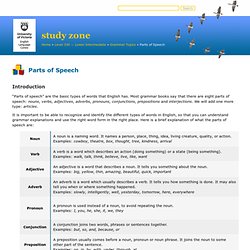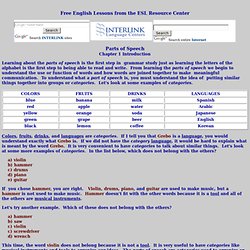

2.3c - Noun Clauses. Adjectives and Adverbs. “Parts of speech” are the basic types of words that English has.

Most grammar books say that there are eight parts of speech: nouns, verbs, adjectives, adverbs, pronouns, conjunctions, prepositions and interjections. We will add one more type: articles. It is important to be able to recognize and identify the different types of words in English, so that you can understand grammar explanations and use the right word form in the right place. Here is a brief explanation of what the parts of speech are: If you are not sure about the basic parts of speech in English, or you would like some more information, try these pages: Parts of Speech (includes determiners which includes articles) The Eight Parts of Speech (doesn't include articles) The Parts of Speech (doesn't include articles) Don't forget to come back here and go on with the exercises! When you are sure that you understand the lesson, you can continue with the exercises.
Adjective Order. Prepositions of Time — for, during, while 1. Noun Clauses. The Parts of Speech. A pronoun can replace a noun or another pronoun.

You use pronouns like "he," "which," "none," and "you" to make your sentences less cumbersome and less repetitive. Grammarians classify pronouns into several types, including the personal pronoun, the demonstrative pronoun, the interrogative pronoun, the indefinite pronoun, the relative pronoun, the reflexive pronoun, and the intensive pronoun. Personal Pronouns A personal pronoun refers to a specific person or thing and changes its form to indicate person, number, gender, and case.
Subjective Personal Pronouns A subjective personal pronoun indicates that the pronoun is acting as the subject of the sentence. In the following sentences, each of the highlighted words is a subjective personal pronoun and acts as the subject of the sentence: I was glad to find the bus pass in the bottom of the green knapsack. You are surely the strangest child I have ever met. He stole the selkie's skin and forced her to live with him. It is on the counter. Prepositions. The Prepositional Phrase. Printer Fabulous!

Recognize a prepositional phrase when you see one. At the minimum, a prepositional phrase will begin with a preposition and end with a noun, pronoun, gerund, or clause, the "object" of the preposition. The object of the preposition will often have one or more modifiers to describe it. These are the patterns for a prepositional phrase: Preposition + Noun, Pronoun, Gerund, or Clause Preposition + Modifier(s) + Noun, Pronoun, Gerund, or Clause Here are some examples of the most basic prepositional phrase: At home At = preposition; home = noun.
Most prepositional phrases are longer, like these: From my grandmother From = preposition; my = modifier; grandmother = noun. Understand what prepositional phrases do in a sentence. A prepositional phrase will function as an adjective or adverb. The book on the bathroom floor is swollen from shower steam. Grammar - Parts of Speech. Free English Lessons from the ESL Resource Center Parts of Speech Chapter 1 Introduction Learning about the parts of speech is the first step in grammar study just as learning the letters of the alphabet is the first step to being able to read and write.

From learning the parts of speech we begin to understand the use or function of words and how words are joined together to make meaningful communication. To understand what a part of speech is, you must understand the idea of putting similar things together into groups or categories. Let's look at some examples of categories. Colors, fruits, drinks, and languages are categories. A) violin b) hammer c) drums d) piano e) guitar If you chose hammer, you are right. Let's try another example. A) hammer b) saw c) violin c) screwdriver d) wrench This time, the word violin does not belong because it is not a tool. The philosopher Aristotle and later scientists studied animals and classified them according to what they have in common. 410 Grammar: Adjective Clauses.